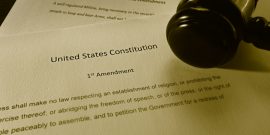The Constitution Permits People to Exercise Two Rights at the Same Time
The ACLU has decided to not to defend the First Amendment rights of those who carry firearms to their protests. This decision betrays its historical commitment to protecting the free speech rights of all. First, people do not lose one constitutional right because they are exercising another simultaneously. Second, free speech doctrine offers ample room to address any problems caused by carrying guns.
The Second Amendment is as much a part of the Constitution as the First. And while the Supreme Court has not yet so held, the best scholarship suggests that the Second Amendment includes a right to possess arms outside the home in some fashion. After all, the right is to “bear arms” as well as to keep them. But even were there no such constitutional right, so long as having arms outside the home is lawful, a state or a municipality cannot condition that statutory right on giving up First Amendment freedoms. To do so would be a classic unconstitutional condition.
In any event, First Amendment doctrine has resources to deal with threats of violence should carrying guns raise them. For instance, it would be a reasonable time, place and manner regulation to separate protesters and counter protesters, if groups are armed.
Indeed, Charlottesville could have done so, had it pursed a more sensible legal strategy last week. Charlottesville tried to revoke the permit which it granted the white supremacist group to march in Emancipation Park and move their protest more than a mile away. But it did not try to move counter protesters from parks only a few blocks away from Emancipation Park. Judge Glen Conrad ruled that this disparity in treatment was content-based. The political leaders in Charlottesville did not like the speech that would occur in Emancipation Park. (Nor of course do I). Its decision thus could not be upheld as a content-neutral time, place, and manner regulation.
Charlottesville would have been on much stronger grounds if it had flipped a coin to decide which group would be relegated to the park a mile away. It could probably have moved the counter protesters there on the basis of a first-come, first permitted policy. Keeping armed protesters who sharply disagree with one another far apart can surely provide the basis a reasonable and neutral time, place and manner restriction. In a world where any substantial protest is now amplified by social media, proximity and place makes less of a difference anyway to the dissemination of a message.
And if any group brandishes arms during a protest or otherwise uses them in a threatening manner, the protest can be shut down under settled First Amendment law as presenting a clear and present danger of violence.
Of course, the ACLU is free to choose to defend whoever it wants. But its willingness to defend people with whom most of the people in its organization personally disagree, including people legally carrying guns, has been central to its core ideals. And the ideal of neutrality is central to the First Amendment itself. While some people claim that only eccentrics want to defend the free speech rights of those who disagree with them, the Supreme Court has done a good job of making that eccentricity the law of the land. And they have gotten crucial support from civil society organizations and intellectuals of all political views. It would be a tragedy for our nation if the ACLU’s decision begins to dissolve the strong social fabric supporting the ideologically neutral First Amendment.


